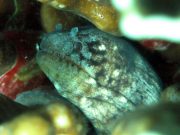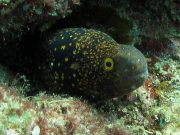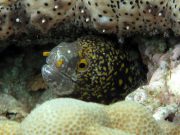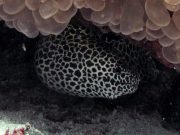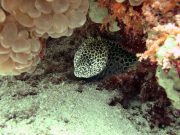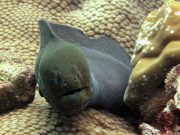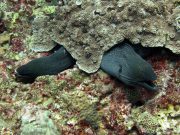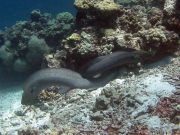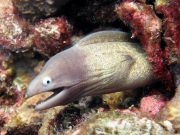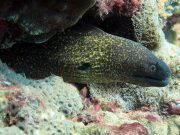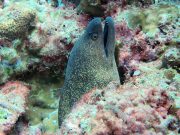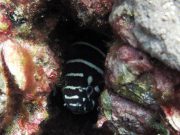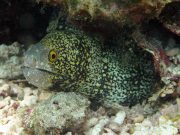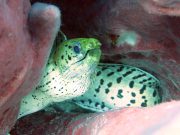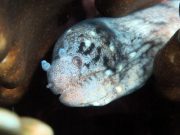There are over 200 species of moray eels found worldwide ranging in size from 10 cm to 3 m in length, with many species preferring to live in warm tropical waters, and several species can be found while diving around Koh Lanta.
Moray eels are often found hiding in reef crevices between rocks, rubble, and hard corals with only their heads protruding. Some species of moray love to settle inside giant barrel sponges.
Even though moray eels have a snake-like appearance, they are not reptiles but fish, continuously opening and closing their mouths to circulate water through the gills, located quite a distance behind the head.
The thick skin is smooth, covered in a protective mucus, and is often patterned. A distinctive dorsal fin runs from the head to the tail.
Morays have small eyes and poor eyesight, using their sense of smell to detect prey such as fish, crabs and octopus, which are captured using an element of surprise.
Since the jaw is rather small, larger prey is first crushed by wrapping the body around the victim, squashing it until it is flat enough to be eaten.
Once the victim has been grasped by the front teeth, a unique second smaller jaw inside the throat, called the 'pharyngeal jaw' is launched, tearing and transporting captured food to the throat and digestive system.
In 1979, the movie 'Alien' showed a fictional alien species using a pharyngeal jaw to attack its victims.
Moray eels can sometimes be observed mating at the dive sites, wrapping their bodies around each other, and laying and fertilising over 5,000 eggs at a time.
Upon hatching, moray eel larvae will float out to the open ocean, living among the plankton near the surface for over 8 months until they become large enough to venture back to the reef.
8 species found on this page.
Blackspotted Moray
(Gymnothorax favagineus)
The blackspotted moray (Gymnothorax favagineus), also known as the honeycomb moray, is a large eel which can grow up to 3m long, however most individuals are significantly smaller than this.
Gymnothorax favagineus @ Koh Haa
This moray is white with brown/black blotches and spaces, sometimes forming a honeycomb pattern. The blotches vary between individuals and size and depend on the eel's habitat. Those found in clear coral reefs usually have less black than those found in turbid waters.
Blackspotted Moray @ Koh Haa
Diver with Blackspotted Moray @ Koh Haa
The blackspotted moray lives on the outer slopes of coral reefs. During the day, it sits sheltered in crevices and at night it leaves its lair to actively hunt its prey along the reef. It feeds mainly on small fish and cephalopods.
Giant Moray
(Gymnothorax javanicus)
At up to 3m long, and weighing up to 30kg, in terms of body mass, the giant moray is the largest moray eel.
Gymnothorax javanicus @ Koh Haa
The giant moray feeds mainly on fishes and occasionally on crustaceans, and due to its position at the top of the reef's food chain, this eel is often ciguatoxic - the moray can absorb and store toxins from other reef fish in its body fat, and is poisonous if eaten by humans.
Giant Morays @ Koh Haa
Giant Morays mating @ Koh Haa
The body is deep with a strongly tapered tail and has a greyish, brownish background color, with juveniles being lighter in color. Black around the gill opening. Adults have black specks on the head that resemble leopard spots further back on the body.
The giant moray has several large sharp canines on both the upper and lower jaw alongside rows of smaller, sharp teeth.
Will attack humans if provoked, and sometimes just for fun.
White-Eyed Moray
(Gymnothorax thyrsoideus)
Gymnothorax thyrsoideus @ Anemone Reef
The white-eyed moray is a medium-sized fish which can grow up to 65cm, but is most usually found around 35 - 45cm. The head is grey with distinctive white eyes.
The body is serpentine in shape, speckled with small dark spots, and has an overall pale brownish/beige color that can vary in strength between different eels.
This eel can often be found sharing its nook or cranny with other moray eels, and sometimes groups of 3 - 5 white-eyed moray can be found together.
The white-eyed moray feeds on crustaceans, small fishes and octopus.
Yellow-edged Moray
(Gymnothorax flavimarginatus)
The yellow-edged moray is similar to the giant moray, but slightly smaller, with a maximum length of around 2.4m.
Gymnothorax flavimarginatus @ Koh Haa
This moray is yellowish with a densely mottled dark brown pattern and orange(ish) eyes. The head is a purplish-grey colour, and the end of the tail has a yellow margin. This moray also has black blotches at the gill openings.
Yellow-edged Moray @ Koh Bida
Yellow-edged Moray @ Koh Haa
Eats fish, including poisonous fish such as lionfish, crustaceans and possibly octopus.
Zebra Moray
(Gymnomuraena zebra)
Gymnomuraena zebra @ Koh Haa
The zebra moray eel is a tan to dark brown moray with irregular close-set narrow white to pale yellow bars or bands, giving rise to its common name.
Even though the zebra moray can reach lengths of up to 1.5m, it is more usually observed around 45 - 55cm.
Gymnomuraena zebra actively hunt their prey at night, and unlike other moray eels, they feed almost exclusively on crustaceans, sea urchins and mollusks.
This eel has a short snout and close-set pebble-like teeth used for crushing hard-shelled prey. Totally harmless to humans.
Snowflake Moray
(Echidna nebulosa)
Echidna nebulosa @ Koh Haa
The snowflake moray has a pale body, generally yellowish/white, with rows of black blotches/bands, yellow eyes and yellow front nostrils.
Reaching up to 1m long, this moray is more usually observed in with 50 - 70cm range.
This moray feeds both during the day, and at night, with shrimp, crabs or lobsters (crustaceans) being their natural diet.
As with other moray eels, their eyesight is modest, compensated by a perfect sense of smell, thanks to two anterior nostrils and two posterior ones shaped like a small tube. The front nostrils point downwards, at the extremity of the snout, and the second ones upwards, at the level of the eye. These nostrils form a sort of all-round smelling radar for hunting, both during the day, and at night.
Completely harmless to humans.
Fimbriated Moray
(Gymnothorax fimbriatus)
Gymnothorax fimbriatus @ Koh Haa
The Fimbriated Moray is a medium sized Moray with a light body color, often whitish, cream or light/pale brown.
The body is covered in many dark spots and blotches which vary with age. These dark spots and blotches are often in small groupings or rows.
The head is yellowish or pale greenish with dark spots and blotches. The mouth is white inside, also with many small black spots.
The Fimbriated Moray grows up to 80 cm and is usually hidden during the day, preferring to feed at night on small fish and crustaceans.
Barred Snake Moray
(Uropterygius fasciolatus)
Main body colour ranges from pale to dark grey with dark bars along the main body. Both upper and lower jaws with rows of fine, sharp teeth. Dark lines behind the eyes. Large secondary nostrils above the eyes.
Uropterygius fasciolatus @ Koh Haa
Found in shallow reefs at depths between 1 and 8m. Hides during daytime and hunts prey during evening hours when it feeds mainly on smaller fish and crustaceans.
Barred Snake Moray @ Koh Haa
Barred Snake Moray @ Koh Haa
This is a very uncommon species and rare to find in the eastern Indian Ocean.
